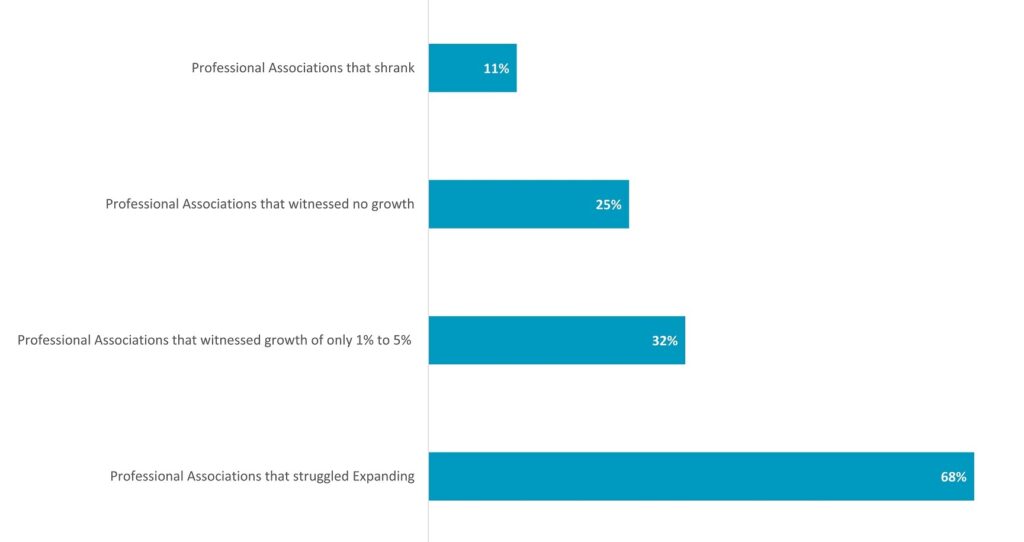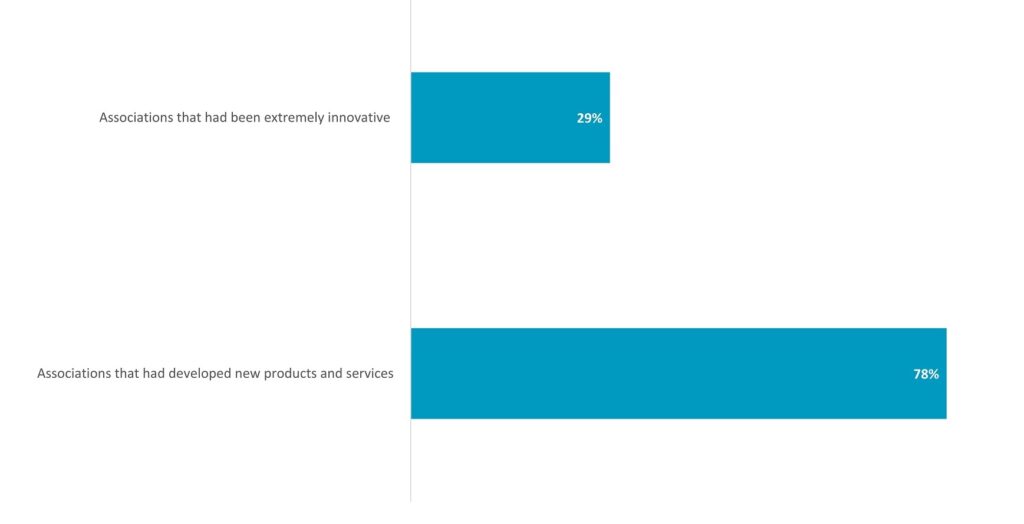
Trends In Professional And Trade Associations
Market Trends
➟ Declining Membership in Professional Associations
Wild Apricot Report in 2019 found that 68% of Professional Associations had struggled to expand, 11% of organizations shrank, and 25% witnessed no growth. The remaining 32% saw a growth of only 1% to 5%.

Professional Associations’ declining memberships are due to financial uncertainty, changing member demands and interests, and challenges connecting with younger members. Gen Z is expected to make up over 27% of the workforce by 2025. Due to changes in the economic environment, individuals place a higher focus on the perceived value of any membership and examine thoroughly whether participation in an organization delivers value to them. It has created a competition for the professional Association as they compete with free resources such as free LinkedIn communities and Facebook groups.
➟ Associations Introducing Member Acquisition Initiatives
According to McKinley Advisors’ 2021 Association Viewpoint report, the number of organizations reporting membership declined nearly doubled in 1 year, with Professional Associations hard hit and Trade Associations faring marginally better.

According to the 2021 Membership Marketing Benchmarking Report, 78% of respondents responded that they developed new products and services in the previous year, and 29% responded they had been extremely innovative in the previous year.
The Professional and Trade Associations are witnessing a rise in the number of members who associate with Generation X and Millennials. Associations that reported gains in one-year and five-year membership numbers are more likely to have a larger proportion of Gen X and Millennials as members.
➟ Adaption of New Membership Model
According to the 2019 Membership Marketing Benchmarking Report, implementing a new membership model may increase membership. Tiered memberships, special interest memberships such as student or retired professional memberships, group memberships, and combination memberships are some of the innovative membership models that associations are experimenting with. In recent years, combination memberships that allow people to join as individuals or as part of an organization have risen in popularity.
The Alliance for Women in Media has adopted a “freemium” approach in which users are given a basic set of privileges for free but must pay for exclusive material. This allows individuals to try out the group and potentially become interested enough to spend money on it, while also providing the group with the enrollment numbers needed to enhance its visibility.
➟ Shift Towards Digital Transformation
Professional Associations are using digital assistance at conferences or annual meeting for their members such as an app, a revised participant management system, or introducing digital experiences within conference sessions. The National Association of College and University Business Officers (NACUBO) has taken an integrated, digital approach to attendee management for its annual meetings. Their system ties registration, badge printing, and CEU tracking into a streamlined digital experience for its members.
➟ The Future Trend of Professional and Trade Associations Based on Knowledge and The Credibility of the Field
More than 93% of Professional Association members and 89% of Trade Association members believe their organization’s function as a trusted source will be extremely essential in the future, making it the highest-rated activity. According to the survey, setting and sharing standards of practice were the second-highest ranked education-related activity among members of both the Professional and Trade Association. More than 89% of Professional Association members and 84% of Trade Association members responded that standard-setting will be extremely essential for the future of their field.
➟ Strategic Partnerships Between Industries and Trade Associations in the US
Collaborations between Industries and Trade Associations are becoming increasingly widespread in the United States to address the country’s rapidly growing supply-chain issues, develop industry fail-safe options, and build cooperative local government relationships following the pandemic. Trade Associations are expanding their traditional roles as industry advocates by positioning themselves as strategic business units and are helping in the creation of policy solutions, implementing advocacy strategies, creating a favorable business environment, and delivering road maps that lead to resilient supply chains.
American Eagle has reached outside traditional thinking and built out a logistics platform that others in the apparel industry can use. Almost 50 other companies are using the platform, and American Eagle is seeking to add an additional 200 brands.
The National Marine Manufacturers Association (NMMA) and the Recreational Boating Industry formed a partnership to promote the great outdoors and the boating experience during the lockdown. Take Me Fishing is a promotional campaign launched by the NMMA’s Discover Boating and the Recreational Boating and Fishing Foundation. The strategic initiative helped the recreational boating industry achieve a 20% year-over-year increase in revenue.
Data Sources: Sidecarglobal, Associations Now, Walsworth, and many more.
Get in-depth Market Research for any industry to understand the Market Size, Competitors, Trends, Future forecasts, SWOT analysis, TAM, SAM or SOM, and many other details. Get in touch with us today.

